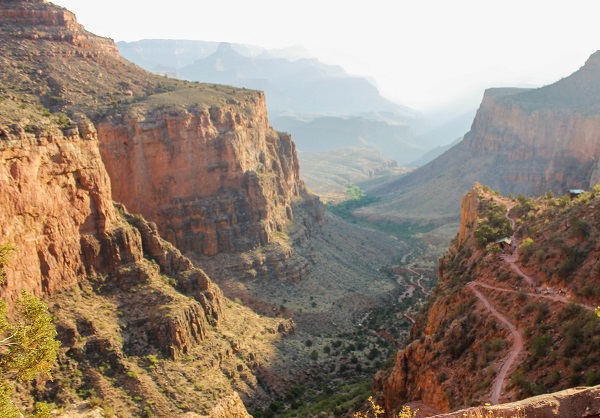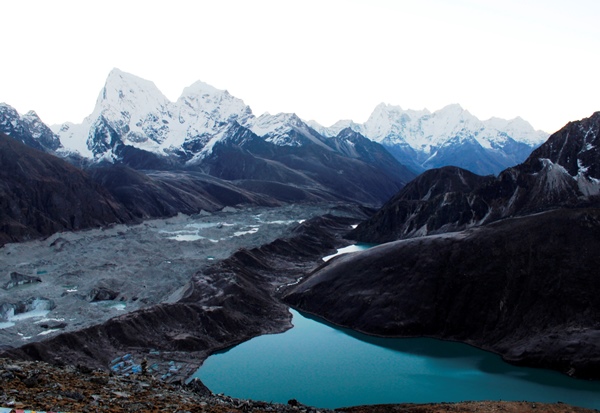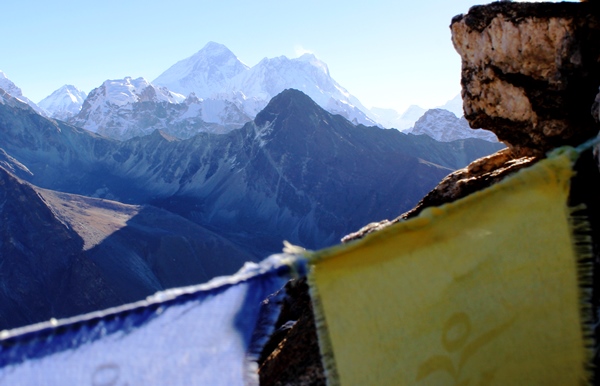When I was a kid, my dad would take my brother and I out to a park somewhere (maybe in Wisconsin?) to go “rock climbing.” Of course, this really wasn’t climbing up rocks, at least not in the sense that we were scaling the sides of cliffs with a bunch of equipment. No, really it was just hiking through the woods where there happened to be some big rocks to hike over as well. Nonetheless, I think these trips subtly instilled in me a love for hiking. And once I started traveling as an adult, I often tried to build in some sort of hiking experience, from a day hike in the hills around Bergen, Norway to a steep climb up Mount Sinai in Egypt.
At some point, I upped the ante and took on multi-day hikes (or, as I would call them, treks). And after trekking in three popular destinations around the world, I thought I would take a look at how similar and/or different the treks were.
Inca Trail vs. Grand Canyon vs. Himalayas
In 2009, I did the four-day Inca Trail trek to Machu Picchu. In fall 2013, I did a two-week trek in the Himalayas to Gokyo Ri; while this isn’t the classic Everest Base Camp route, it crosses through many of the same villages and is generally comparable. Finally, this spring, I did a four-day trek in the Grand Canyon from the north rim to the south rim (known as the “rim to rim”), one of the best known canyon treks. Here’s how they stack up:
Altitude
The Inca Trail was my first experience in high altitude (up to 4200 meters) and I found that pretty challenging. While I took Diamox to combat altitude sickness, I still struggled to breathe during the uphill portions of the trek. However, the Himalayas went even higher. While on the Inca Trail, we simply crossed a pass that was above 4000 meters, in the Himalayas, we spent several nights sleeping above 4000 meters and two night above 5000 meters. The Grand Canyon, on the other hand, didn’t present any altitude-related issues.
Level of difficulty
Each trek presented its own difficulties. I probably struggled with my breathing more on the Inca Trail than I did in the Himalayas, despite being at a much higher altitude than in Peru. The terrain was probably the easiest in the Grand Canyon and hardest in the Himalayas, with several stretches of large rock “staircases” to climb up or down. While the weather was the hottest in the Grand Canyon, it was more unpredictable in the Himalayas, with rain showers making the trek very difficult for a couple of days. Overall, I would say the Himalayas were the most difficult and the Grand Canyon the easiest (relatively speaking).
Accommodations
These can vary depending on what you are willing to spend, but in general the Inca Trail and the Grand Canyon were all about camping, while trekking in the Himalayas meant staying in rustic tea houses. However, I saw plenty of people camping in the Himalayas as well. If I had done a higher end rim-to-rim trek in the Grand Canyon, I could have stayed in a cabin at Phantom Ranch at the bottom of the canyon instead of camping, but that is the only place where a non-camping option is available. The tea houses in the Himalayas, while offering the comfort of a bed, lacked heat and sometimes indoor plumbing or electricity, but I have heard there are higher end lodges available.
Toilet and shower facilities
As I recall, the Inca Trail featured flushing squat toilets at each campsite and there was access to a shower at our campsite on the third (and final) night – for a small fee (I passed). On the other hand, the Grand Canyon offered no showers along the way, but plenty of creeks to dip into and composting toilets at campsites and rest houses. The Himalayas fell in the middle – some tea houses had Western style toilets that flushed, some had toilets that required you to pour a bucket of water in to flush and some had traditional squat toilets. Showers were even available every 2-3 days at the places we stayed, albeit somewhat makeshift with little water pressure in most cases.
Water
When you are hiking for several hours a day, water is a major concern to stay hydrated. When you are in rural areas or developing countries, the quality of the water is of the utmost importance – the last thing you want on a multi-day trek is to come down with a stomach bug from drinking contaminated water. Along the Inca Trail, our porters took care of boiling and purifying the water for us and we refilled our water bottles from them each day. In the Himalayas, we each carried a Steri-Pen and used that to purify the water we got from teahouses along the way. Other trekkers bought bottles of water at each tea house – a huge waste – or boiled their water or use purification tables (which can leave a funny taste and take much longer than Steri-Pens to work). The Grand Canyon proved to be the easiest as every campground had taps with drinkable water.
Porters and guides
While you can hike in the Himalayas or the Grand Canyon independently, you must have a guide to hike the Inca Trail. If I had a good amount of trekking experience and was traveling with another experienced trekker, I would probably feel okay doing the Grand Canyon without a guide, but I would definitely hire one in the Himalayas. Sure, it’s easy enough to figure out the path, but it was incredibly helpful to have a local guide who helped us secure rooms at the tea houses each day, told us stories about the mountains and interpreted for us as necessary. I also think a guide is useful from a safety perspective in the Himalayas, especially when altitude sickness can be a significant risk.
With respect to porters, without a porter or animal (i.e., a yak or mule) carrying your gear, you must carry your own. In Peru and Nepal, I only carried a day pack with a rain poncho, camera, water and snacks. In Peru, we had to put the rest of our gear into a company-provided duffel that was limited to exactly 6 pounds – and they were very strict on that! In Nepal, my main pack, a 65 liter Eagle Creek pack, was stuffed to the gills and weighed around 15 pounds, although they were not nearly as strict about that as they were in Peru.
In the Grand Canyon, I had to carry all of my own gear (although other treks in the canyon do allow for mules to carry trekkers’ gear) and I was initially very apprehensive about it. My pack probably weighed around 25-30 pounds, which included my clothes, sleeping bag, sleeping pad and a lightweight single person tent. It ended up not being so bad and gave me confidence that I could carry my own gear on a trek in the future if necessary.
Scenery
These three hikes provide very different environments – and the scenery on each will vary depending on the time of year you go. I found the Inca Trail interesting because of the ruins we passed or stopped at along the way and the fact that we ended up at Machu Picchu. Due to a lot of rain and foggy skies while we were trekking, though, the scenery during the trek itself was not that memorable. In the Himalayas, I loved the prayer wheels, flags and mani stones that we passed throughout the trek and they were some of the most interesting things to photograph. While the mountains were certainly impressive, I didn’t feel like the view changed that much day to day. On the other hand, the view in the Grand Canyon changed throughout each day. As we descended from the north rim to the bottom of the canyon and back up to the south rim, we passed layers of sandstone, limestone and shale. The colors were incredible and everything was far more green than I had expected. It was by far my favorite trek.


Have you trekked the Inca Trail, Himalayas and/or Grand Canyon? Share your experience below!






Thanks for the info and quick reply Katie. I bought my ticket today; kick of 6 weeks in the USA and Mexico,(if I can’t see Machu Picchu this year, then I’ll make do with Chichen Itza and Palenque from San Francisco in early June, .
Couple more questions on the Grand Canyon if I may. Is trail from rim to rim obvious, will I need maps? Which nearby town should I base myself (where I can also hopefully leave my stuff while I’m in the canyon) to start from north rim, Flagstaff?
Cheers
Tony
Hi, I’m from Australia. I did the trek from Jiri to Everest base and Kala Pattar 4 years ago; quite a bit longer and tougher that what most people do, (i.e. start from Lukla). But it does provide some of the best scenery and interaction with local people, (in the 8 days before reaching Lukla we saw a total of 5 westerners, from Lukla onwards it was wall to wall westies.
I had planned (badly as it turned out) to do the Inca trail this year, but have only just learned that it is all booked out October. For me it had to be June-July, August at a stretch. Apparently only 500 people are allowed on the trail per day, this includes guides, porters and support staff; only about 200 actual trekkers.
So no I’ve decided on an American road tip instead. After I get my kicks on route 66 I thought I’d revisit the Grand Canyon and do the Rim to Rim trek. Looking on line all I’ve found info on are organised treks provided for agencies for which they want in the order of $1000 for which they dont provide porters.
Can you, (or anyone else reading this) suggest where I can get info on independent trekking.Can I camp anywhere or are there official camp-sites that I have to use. Not so concerned with water as at worst I could purify creek water and then run it through a filter bottle to get rid of the taste. How about food though, do I have to carry 3 days worth or is there an alternative.
cheers
Tony
Hi Tony – I think it’s easy enough to trek on your own, but you have to get a permit to stay overnight in the canyon. For water, there are rest points along the Bright Angel Trail (going up the south rim) to refill (assuming you go north rim to south rim). For food, there is a canteen at the bottom of the canyon where you can get meals but you’d need to carry your own food for the rest of the trek.
I have trekked in Himalayas in India in the states of Uttarakhand and Himachal Prasesh. Simply stunning beauty and a gratifying experience. You may come and explore the Himalayas at their nascent best here.
I’ve been starting to make some very loose plans to return to the Himalayas next spring for some trekking, so this post couldn’t have been better timed! Then again, I’ve never trekked on the Inca Trail…
Hi. I read this post cause I am heading to the canyons. I came across your plan for the Himalayas. I can tell you. its bliss- I have teekked at about 8 locations in the Himalayas and ecen nepal.
I am not into it commercially. Just an enthusiast. I am frmo India itself . If you need help,,,,on any cancetual planning, let me know. WHO you trek with in india…is EXTREMELY important….